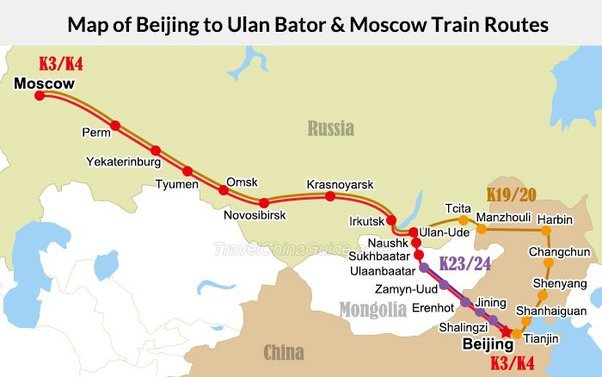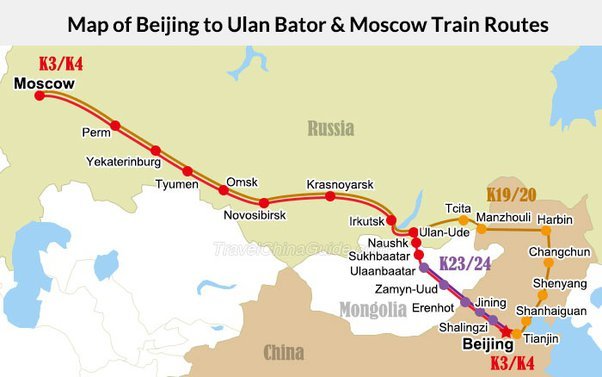Previously, the PRC was ready to allocate more than 350 billion rubles to finance the creation of high-speed rail in Russia

In March 2024, construction of the first high-speed railway (HSM) in Moscow – St. Petersburg began in Russia. The route, 679 km long, will pass through six regions. Its duration without stops will be 2 hours 15 minutes, and the train speed will exceed 250 km/h. Russian President Vladimir Putin emphasized that during construction “primarily domestic developments and equipment” should be used.
The issue of high-speed rail construction in Russia was raised back in Soviet times. The decree on the creation of the St. Petersburg-Moscow high-speed railway was signed in 1991 by the President of the RSFSR, Boris Yeltsin. But by the end of the 1990s, it became obvious that it was impossible to attract foreign investment in the project, and RAO High-Speed Railways, which was created for the project, went bankrupt.
The next intention to build the first high-speed route appeared at the turn of the 2000s and 2010s. Then the talk was about the construction of the Moscow-Kazan high-speed railway with a subsequent extension to Yekaterinburg. The plan became even more ambitious when Russia and China signed a memorandum of cooperation in 2014. The route Moscow – Kazan (travel time – 3.5 hours) was supposed to become part of the Eurasian high-speed transport corridor Moscow – Beijing project. In 2015, China was ready to allocate 104 billion rubles for the construction of the Moscow-Kazan high-speed railway. as a contribution to the capital of the project company and provide lending in the amount of more than 250 billion rubles. But the project remained only on paper: Deputy Prime Minister Marat Khusnullin explained this by high financial costs and low potential passenger traffic. The implemented alternative was the M-12 Vostok highway
How did the development of high-speed railways proceed in China?
China is the world leader in HSR: the length of HSR networks in the country by the end of 2023 is 45,000 km (two-thirds of the total number of HSR networks in the world). However, the country began to develop them only in the 2000s: the first line was built in 2003, it connected the Qinhuangdao resort in Hebei province and the city of Shenyang in the northeast of the country. The project was estimated at $1.9 billion.
The peak of development of high-speed rail (gate in Chinese) in China occurred during the global economic crisis of 2008–2009. Thanks to investments in high-speed rail, new jobs were created, and the economy received an additional impetus for growth. The Beijing-Tianjin high-speed railway was opened for the 2008 Summer Olympics. By 2009, investments in high-speed lines in China reached $88 billion. The project formula “4 + 4” was determined – four meridional high-speed lines from north to south and four latitudinal lines from east to west.
Initially, foreign technologies were used on Chinese high-speed lines. The then-existing Chinese Ministry of Railways turned to the experience of the Japanese “railroad miracle” Shinkansen. However the historical background between the countries caused the rejection of cooperation in the PRC. As a result, French and Canadian technologies Alstom and Bombardier were involved in the development of networks in China. This contributed to the development of our own technological developments.
The launch in 2011–2012 was significant for China. highways Beijing – Shanghai (1,300 km, four hours drive) and Beijing – Guangzhou (more than 2000 km, eight hours). In 2018, the latter route was extended to Hong Kong.
The large-scale launch of Chinese high-speed lines could not have happened without incidents. In 2011, two high-speed trains collided on an overpass in Wenzhou, killing 40 people and injuring 192. After the accident, the Chinese authorities temporarily froze the construction of new roads and tightened construction requirements.
A new boom in high-speed rail construction in China began in 2014 under President Xi Jinping. HSR systems have appeared not only on the developed East Coast but also in underdeveloped areas of the country. For example, a 1,776 km long road connected the capital of Gansu province, Lanzhou, with the capital of the Xinjiang Uygur Autonomous Region, Urumqi.
In the 2010s. Chinese authorities are also thinking about entering foreign high-speed rail markets.
In July 2014, a high-speed railway between Ankara and Istanbul was opened in Turkey, built with the participation of China Railway Construction Corporation (CRCC). In December 2021, a road was opened between the Chinese Kunming and the capital of Laos, Vientiane (the project is part of the Belt and Road Initiative). China owns 70% of the joint venture, and Beijing hopes the line will be extended to Singapore via Thailand and Malaysia.
In October 2023, with the participation of the PRC, the first high-speed railway in Indonesia was launched – between Jakarta and Bandung. The project was implemented by PT Kereta Cepat Indonesia-China, a joint venture between an Indonesian consortium of four state-owned companies and China Railway International Co.
In 2020, at the height of the coronavirus pandemic, China Railway Group announced a goal to increase the length of HSR networks in China to 70,000 km by 2035. It is planned that HSR access will be available to all cities in China with a population of more than 500,000 people.
The main argument against using the Chinese experience is the unprofitability of most high-speed lines in China. Under the conditions of state regulation of the economy, the strategic goal of creating high-speed railways, in addition to the economic effects of their construction and the construction of related infrastructure, was to increase transport connections between regions. In China, it is customary to say that only hieroglyphs (i.e. writing) have done more for the unity of the country. In Russia, to solve the problems of launching high-speed rail, it is advisable to use Chinese experience, at least in terms of standardization, says Yuri Sahakyan, general director of the Institute for Problems of Natural Monopolies. “Developing your own standards from scratch is a long process, not comparable to the time frame within which the project needs to be launched,” he notes. In China, standards were developed in parallel with the development and operation of equipment and infrastructure, and this is a risky path, the expert explains. He adds that China managed to test various technologies and settled on the optimal ones, and this experience “is undoubtedly applicable and in demand in Russian realities.”
Russia is trying without the Chinese
The project of the first high-speed railway in Russia is being implemented within the framework of a concession agreement concluded between Roszheldor and LLC “High-Speed Railway Two Capitals”, the Ministry of Transport told Vedomosti. The concessionaire accepted obligations for the implementation of the project, including the construction of infrastructure. The sole shareholder of VSM Dve Stolitsy is JSC Management Company VSM Dve Stolitsy, the founders of which were the Moscow government and CJSC Leader.
As the press service told Vedomosti Russian Railways, the design of the high-speed railway is currently ongoing. “To implement the project, it is planned to attract the best domestic construction and engineering resources,” they emphasized. The company’s press service clarified that as part of the project, a “new generation infrastructure” will be built, including a contact network using new materials and alloys, designed for speeds of up to 400 km/h. At the same time, the development of a Russian electric train capable of reaching such speeds is being carried out by the engineering center of railway transport (a joint venture of Russian Railways and the company “Sinara”-transport vehicles”), as well as scientific and engineering institutions. There is no talk of any participation of the Chinese side in the project, Russian Railways noted.
At the same time, Deputy Head of the Ministry of Transport Valentin Ivanov said in May 2023 that Russia offered Chinese companies to take part in the construction and financing of the high-speed railway. He clarified that it is necessary to create appropriate “conditions for attraction.” And Deputy Mayor of Moscow Maxim Liksutov in June of this year, in an interview with the Chinese Xinhua agency, stated that Russia had studied China’s experience in the field of high-speed rail – in particular, the example of the Chinese Fuxing trains.
President of the Research Center “Transportation and Infrastructure” Pavel Ivankin notes that the creation of high-speed rail can go in three ways: sovereign, when all technologies are developed within the country, imported, when technologies are supplied from abroad, and also through joint implementation, when advanced technologies of partners are used.
The Russian government is trying to solve the problem of launching high-speed rail first, notes Ivankin. According to him, until 2022, Russia was considering attracting European partners, and Russian specialists are “very cautious” about Chinese technologies due to doubts about their reliability. In addition, we are talking about the prestige of the country, adds Ivankin. “You need to enter the club of HSR countries with your own technologies, and this is what the government is fighting for,” explains the expert.
Chinese interest
In the Moscow-St. The Petersburg high-speed rail project, cooperation on developing a high-speed train could be of greatest interest to China, says Mikhail Burmistrov, general director of Infoline Analytics. In his opinion, equipment supplies (automation, remote control) from China are also possible.
NRA Corporate Ratings Director Alla Yurova admits that when implementing the project, some technologies and materials can be purchased from Chinese companies, and consulting support can be received.
According to Sahakyan, Chinese businesses are interested in entering a new promising market, given that the high-speed rail network in China is “close to the limits of development.” “Chinese business is interested in entering the Russian market right now when ambitious goals are being set in a short time frame and there is the necessary amount of investment,” the analyst believes.










